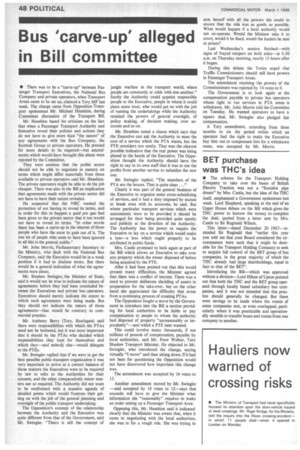Hauliers now warned of crossing risks
Page 50

Page 51

If you've noticed an error in this article please click here to report it so we can fix it.
• The Ministry of Transport had never specifically focused its attention upon the slow-vehicle hazard at level crossings. Mr. Nigel Bridge, for the Ministry. told the inquiry into the Nixon crossing accident— in which 11 people died—when it opened in London on Monday. Since the accident the Ministry had circulated hauliers warning them of the need to instruct drivers to use the phone at a level crossing before going over, when they were carrying abnormal loads. The Home Office had now been asked to tell chief constables of the need for phones to be used, and more radical measures were under study.
For British Railways, Mr. Edgar Fay QC. said BR's system for dealing with exceptional loads assumed that those controlling the load would stop and phone the signalman. The signals for the train were set at danger before the signalman gave permission to cross.
Mr. Morris Finer QC. for Robert Wynn and Sons, owner of the transporter involved in the accident., said the reason why the signalman had not been phoned was that neither the police nor the crew had any foreknowledge of the necessity to phone the signalman: the notice board was not seen because it was sited in a position and line where it could not be easily seen from an approaching vehicle.
There seemed to have been a wholly ineffective liaison between the Ministry, BR, Wynn and the police, said Mr. Philip Owen QC, representing one of the bereaved families. His clients felt that some culpability rested upon the Wynn management; it should have been put on its guard by the Leominster incident in November 1966. when one of the firm's lorries stalled on an automatic level crossing.
The Attorney General, Sir Elwyn Jones QC, said it seemed certain that the transporter entered the crossing while the barriers were raised and before the warning signals were given. To avoid disaster. the 144ft-long transporter would have had to travel at more than 5 mph: it did not get near this speed, he said. Sir Elwyn commented that it would seem obvious that if a load of such. size was to be allowed to use automatic level crossings, different conditions should prevail.
Referring to photographs before the court, of a sign which read: -In emergency or before crossing with exceptional or heavy loads or cattle, phone signalman", Sir Elwyn said the notice had not been "square" to traffic. He added: "One can hardly see there is a notice there, let alone what is on the notice".
Photographs taken later showed that the notice had been re-sited and turned towards oncoming traffic,
Earlier, Sir Elwyn had said that in spite of the near-accident at Leominster, Wynn had given no warning to its drivers. Referring to correspondence between Wynn and BR (CM, Feb. 2) he quoted a BR letter which read, in part: -road vehicles must not become immobile on these crossings . . .'' Sir Elwyn said: "You may think that is a truly remarkable answer".
The inquiry, under the chairmanship of Mr. Bran Gibbens QC, is expected to take two weeks.








































































































































































